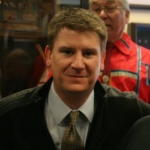
Dr. James Buss
How a Trip to the Lincoln Center Changed Everything I Thought I Knew About Teaching
Posted by Sep 12, 2016 0 comments

Dr. James Buss
“Of course I know about arts integration,” I told the search committee during my interview at Oklahoma City University (OCU). After all, I had already taught a course titled, “Society, Culture, and Rock and Roll,” at my previous institution. Little did I know then, what I know now. . . that I knew virtually nothing about arts integration.
Despite my deficiencies, the Department of History at OCU hired me as a tenure-track professor of American history.
Soon after joining the faculty at OCU, I applied to take part in a fellowship program whose goal was to integrate the arts across the curriculum. The program, “The Priddy Fellows,” was funded through a generous donation by the Priddy Foundation and hosted by the university’s Center for Excellence in Teaching and Learning. It brought together faculty members from across campus and from all disciplines to learn how arts integration could be implemented on a college campus. In 2009, eight of us joined the fourth cohort of fellows.
Each year the Priddy Fellows spent part of their summer on the road, attempting to employ what they learned “on the ground.” Previous fellows had traveled to San Francisco, Chicago, and Santa Fe. My group was particularly lucky; we were assigned to visit New York City.
After a year of discussing scholarship about aesthetic education, from John Dewey to Maxine Greene, we journeyed to the Big Apple. There, we worked with Jean Taylor at the Lincoln Center Institute (now Lincoln Center Education). It was at the Lincoln Center that I discovered something about my own pedagogy: I was doing it all wrong. Introducing students to art was not the same as integrating the arts into the curriculum.
Even the location of our “class” signaled a change about how we might think about arts integration. Rather than meet in a typical classroom, we met in a dance studio. For some of us, it was uncomfortable. I had grown accustom to teaching and learning in a traditional academic setting. How would I adapt to this space? And, what were we supposed to do with the ballet barres and the mirrors that lined the walls?
Over the course of our time at the Lincoln Center, the space symbolized the greater challenge facing us as educators. How could we take the art that many us were already introducing into our classrooms and make it central to the learning experience? More importantly, how could we move from the observation of art to the performance of it?
At the Lincoln Center, we studied the “Capacities for Imaginative Learning” (now labeled the Capacities for Imaginative Thinking). They are drawn from more than forty years of experience by the Lincoln Center Institute and the work of Maxine Greene (we even were lucky enough to meet Greene in the summer of 2009 during our residency at the LCI).
At the time they included nine capacities (now slightly altered and extended to ten):
- Noticing Deeply
- Embodying
- Questioning
- Making Connections
- Identifying Patterns
- Exhibiting Empathy
- Creating Meaning
- Taking Action
- Reflecting and Assessing
Most of these seemed capacities familiar. Previously when I introduced art to students, I asked them to notice deeply, question, make connects, identify patterns, etc. These all seemed natural. However, one of the capacities seemed foreign: take action. Taking action, according to the guide, meant “to act on the synthesis of what you have learned in your explorations through a specific project. … For example: you might write and produce your own play; you might create a dance.”
During our time at the Lincoln Center, the resident artists put us through our paces. The eight faculty members, including myself, were asked to sing, make music, act, and construct pieces of art. For those of us who were biologists, political scientists, philosophers, psychologists, sociologists, English professors, and historians, we had never been asked to take such actions in this way.
At the end of our residency, we traveled home to Oklahoma and began developing courses whereby we integrated the arts into our classrooms. I teamed up with a colleague in the Department of Music, Brenda Holleman, who was the sole artist among our group of Priddy Fellows. Together we taught a history course titled “Performing Race and Ethnicity in America,” whereby students studied the history of the performing arts but also performed their assignments in the classroom. We held individual classes in a black box theater, on the stage in a music hall, and in the dance building. Through the process of taking action, the students learned to self-reflect and make meaning of their experiences. In the end, they learned far more than they would in a traditional classroom.
I’ve since left OCU to serve as Dean of the Honors College at Salisbury University. Even so, I’ve taken the lessons of the Lincoln Center with me. This semester, my students will perform in their classes by constructing five-minute theatrical productions to better understand the poetry and prose of the Harlem Renaissance and by composing songs in the style of the Broadway blockbuster "Hamilton" to study the American Revolution. While I will certainly be introducing them to art, music, and theater, I have realized that the best learning comes through doing.
